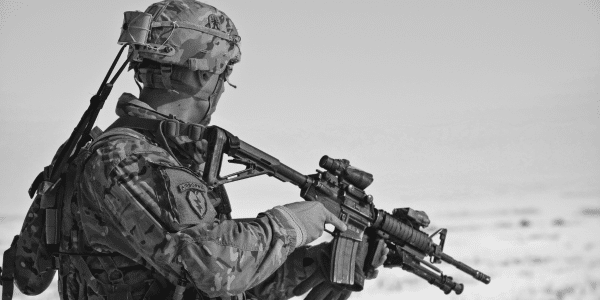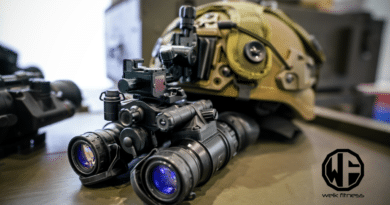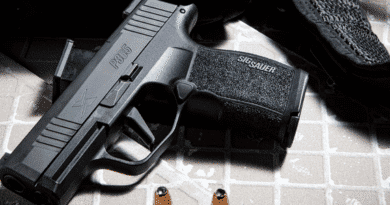Strategic Support: Choosing and Using the Ideal Rifle Sling
Whether you’re out on a hunt or hitting the range for some tactical training, having the right rifle sling can make all the difference in your shooting experience. It’s not just about keeping your hands free; it’s about maintaining control and readiness of your firearm.
But with so many options available, choosing the perfect sling that fits both you and your rifle can seem like a daunting task.
Did you know? A well-chosen rifle sling is key to stabilizing shots over long distances and safely managing your firearm. This article aims to simplify this critical decision by breaking down different types of slings and their features while providing easy-to-follow tips for effective use.
This guide will make finding the ideal balance between comfort and functionality easier than ever. Are you ready to find your ideal rifle sling? Let’s dive into it!
Key Takeaways
- Rifle slings come in various types, such as traditional, comfort stretch, single-point, and two-point, each serving different shooting styles and needs.
- Important features to consider when selecting a rifle sling include the presence of swivels for movement flexibility, adjustable length for fit and comfort, padding like neoprene for shoulder support, quick-grab handles for easy access, and thumb holes for added stability while aiming.
- Proper use of a rifle sling involves adjusting it to suit your body size and carrying style while mastering different techniques to ensure quick access to your firearm.
- Swivels allow the rifle to rotate smoothly, which is vital in scenarios requiring rapid target acquisition or position changes.
- The correct choice of a rifle sling can enhance shooting accuracy and provide essential support in both tactical environments and long-range precision shooting.

Table of contents
Types of Rifle Slings
Traditional slings, comfort stretch slings, single-point slings, and two-point slings are the main types of rifle slings to consider when choosing the ideal one for your needs. Each type offers unique advantages that cater to different shooting styles and preferences.
1. Traditional Slings
Traditional slings hold a place of honor in the world of firearms. Steeped in history, these leather or canvas straps have supported the US military rifles and shotguns for generations. They offer a straightforward approach: one end attaches to the buttstock and the other near the barrel, providing a reliable method to carry your weapon over the shoulder or across the back.
Hunters appreciate them for their durability and simplicity, that has stood the test of time.
Craftsmanship shines in every stitched seam and buckle on these classic gun slings. They embody pride from yesteryears but remain relevant today, especially for those who value aesthetics alongside functionality.
Each sling is often customizable with color options, allowing shooters to match their gear with precision. You can find an array of traditional slings tailored for comfort as you trek through outdoor terrains seeking game or practicing sharpshooting skills—true partners in hunting heritage.
2. Comfort Stretch Slings
Comfort Stretch Slings offer a unique blend of support and flexibility for firearm enthusiasts. Their design incorporates materials like neoprene or bungie, which molds to your shoulder, providing cushioned comfort without sacrificing stability.
Personally, I’m not a fan of this style (but to each his or her own). The movement and “bounce” that the sling causes, in my opinion, is not ideal. But you may find it to be useful and comfortable.

These slings ease the burden on your body during long hunts or extended periods at the range. Users will appreciate the reduction in felt weight and how these slings prevent fatigue from carrying heavy rifles.
Many Comfort Stretch Slings come with adjustable straps, allowing shooters to find the ideal fit regardless of body size or clothing layers. They often feature swivels that enable easy attachment to various firearms while ensuring smooth transitions between shooting stances.
Whether you are navigating rough terrain or standing still for precision shots, these slings remain durable and reliable under stress, enhancing both performance and convenience in every tactical situation.
3. Single-Point Slings
Single-point slings offer tactical shooters swift maneuverability with their rifles. These single point gun slings attach to just one point on the firearm, typically at the rear of the receiver, allowing for quick transitions to a sidearm without interference from the sling.
This setup is ideal for dynamic environments where speed and ease of movement are paramount.
They’re particularly popular among military and law enforcement personnel who need to quickly switch from carrying a rifle to engaging in close-quarters combat. With lightweight designs and often featuring padding or elastic material for added comfort, single-point slings provide minimal restriction and a full range of arm motion.
Whether navigating through tight spaces or responding rapidly in high-pressure situations, having your rifle secured by a reliable single-point sling ensures it’s always ready at your side.
4. Two-Point Slings
Two-point slings provide excellent stability and versatility for rifle users and are my personal favorite type of rifle sling. These two point slings feature two attachment points, allowing for a balanced distribution of weight across the body.
This design enhances control and reduces strain during extended periods of carrying or aiming your firearm. With two secure anchor points, the rifle remains easily accessible while also offering hands-free mobility, making it an ideal choice for self-defense situations and tactical maneuvers.
Additionally, two-point slings are known to facilitate smooth transitions between shoulders, enabling quick adjustments without compromising on comfort or support. The ability to maneuver your rifle seamlessly is vital in dynamic scenarios where speed and precision are essential.
Features to Consider When Choosing a Rifle Sling
When choosing a rifle sling, consider features like swivels for ease of movement, adjustable length for comfort, neoprene padding for shoulder support, quick-grab handle for easy access, and thumb hole for stability.
To learn more about the ideal rifle sling for your needs, continue reading on.
1. Sling swivels mount for ease of movement (metal QD sling)
Swivels on a rifle sling are essential for enhancing maneuverability and quick target acquisition. These swivels allow the user to rotate the rifle smoothly, providing flexibility in different shooting positions.
Swivels facilitate seamless movement without compromising stability, whether switching between targets or transitioning from a standing to a prone position. With the ability to pivot and adjust your aim swiftly, swivels on a rifle sling enable shooters to maintain control over their weapon while adapting to dynamic scenarios.
Related Article: The Benefits of an AR Pistol for Home Defense
Incorporating swivels into a rifle sling design offers ease of movement and contributes significantly to the overall shooting experience. By allowing fluid rotation and adjustment, these swivels empower users with greater precision and agility when engaging targets, making them an indispensable feature for self-defense situations or tactical applications where speed and accuracy are paramount.
2. Adjustable length sling strap for comfort
To ensure optimal comfort while using your rifle sling, look for one with an adjustable length feature. This allows you to customize the fit according to your body size and shooting position, providing a snug and supportive feel.

With an easily adjustable length, you can maintain proper weight distribution and reduce strain on your shoulders during extended use.
The ability to fine-tune the length of your rifle sling enhances overall shooting stability and ensures that it complements various tactical situations. Adjustable slings allow for flexibility in movement without compromising on comfort, making them a valuable addition to your firearm gear.
3. Neoprene padded sling for shoulder support
Neoprene padding on your rifle sling offers crucial shoulder support, enhancing comfort during extended shooting sessions. The padded design helps distribute the weight of the rifle evenly, reducing fatigue and strain on your shoulder muscles.
This feature significantly improves shooting stability and overall performance—essential for sharpshooters who require steady aim for precise long-range shots while keeping their hands free for other tactical movements.
In various tactical situations, neoprene padding ensures that your shoulder remains comfortable and supported, allowing you to maintain focus on the target without distractions or discomfort.
4. Quick-grab handle for easy access
The quick-grab handle provides immediate accessibility, allowing for swift rifle deployment in critical situations. With this feature, you can efficiently transition from a relaxed carry to a ready shooting position with minimal effort.
Whether for self-defense or tactical scenarios, having the ability to swiftly grab and maneuver your firearm is essential for maintaining control and readiness, ensuring that you are prepared for any potential threats at all times.
The incorporation of the quick-grab handle into your rifle sling enhances its usability in high-pressure situations. This feature offers added confidence as it allows for rapid response without compromising on stability or comfort during handling.
5. Thumb hole for stability
The thumb hole in a rifle sling is designed to provide stability and control while aiming and shooting. This feature allows the shooter to secure their hand through the loop, enhancing support and accuracy when handling the firearm.
Shooters can maintain a firm grip on the rifle by utilizing the thumb hole, minimizing movement, and ensuring steady control during critical moments. This added stability can make a significant difference when taking long-range shots or maneuvering in tactical situations, ultimately improving overall shooting performance.
Quality rifle slings incorporate a thumb hole for stability as they offer shooters an additional point of contact with their weapon, promoting steadiness and precision. With this feature, individuals can confidently handle their rifles with enhanced control and confidence, providing essential support for maintaining accuracy in various shooting scenarios.
How to Properly Use a Rifle Sling
Properly using a rifle sling involves adjusting the length for a comfortable fit, positioning it properly on your shoulder, and mastering different carrying techniques. To learn more about how to maximize the benefits of your rifle sling, keep reading for actionable guidance.
1. Adjusting the length of a rifle sling
Adjusting the length of your rifle sling is crucial for finding the right fit and maximizing comfort. By ensuring the sling is adjusted to the appropriate length, you can maintain proper positioning and stability while carrying or using your rifle.
Whether it’s a traditional two-point sling or a tactical single-point one, having an adjustable length allows you to customize the fit to suit your body type and shooting style effectively.
Additionally, proper adjustment of the sling’s length enables quick access methods and carrying techniques, enhancing your overall shooting experience. The neoprene padding or swivels may offer convenience, but getting the length just right ensures optimal support and functionality when utilizing your firearm in different situations, making it a vital aspect of using a rifle sling efficiently.
2. Proper rifle sling positioning
To ensure proper positioning of your rifle sling, start by adjusting the length to fit comfortably across your body. Keep the sling positioned diagonally across your chest and shoulder, allowing for quick access to your firearm when needed.
Related Article: Simulating Real Threats — The Dynamics of Force-on-Force Training
Maintaining a balanced and stable stance while using a rifle sling can significantly improve shooting stability and overall performance. Remember that the right positioning will allow you to have both hands free for maneuvering in various tactical situations.
The correct positioning of your rifle sling is crucial when utilizing rifles beyond target practice, especially for defensive purposes. By ensuring that the sling is properly adjusted and positioned, you can enhance the functionality of your rifle and improve its effectiveness in different shooting scenarios.
3. Gun sling carrying techniques
Adjusting the length of your rifle sling is crucial for finding a comfortable and secure fit. Position the sling diagonally across your body, allowing easy access to your firearm while maintaining stability.
Utilize quick-grab handles or thumb holes for rapid deployment in defensive situations. When navigating through tight spaces, consider transitioning to a muzzle-down orientation for better maneuverability without compromising readiness.
Employing proper positioning and padded slings for extended carry periods can significantly reduce shoulder strain and fatigue. Take advantage of swivels for ease of movement when on the move, ensuring that you remain agile and ready to engage targets at a moment’s notice.
4. Quick access rifle sling methods
Accessing your rifle quickly can be essential in tactical situations. Opt for slings with quick-grab handles or innovative thumb holes to swiftly retrieve your weapon when every second counts.
Look for models equipped with QD (quick detach) sling swivels, ensuring effortless and speedy detachment from the rifle for immediate use.
When transitioning from carrying your rifle to firing it rapidly, opt for a combat sling with convenient features that enable seamless access. Choose slings designed specifically to facilitate swift and easy manipulation of your firearm, ensuring readiness in critical moments without compromising on stability or security.
That being said, you should also have your rifle sling staged with something like the Neomag Sentry Strap or the First Wave Sling Doober.
What Do I Recommend for a Rifle Sling?
The answer is probably your favorite response—it depends.
But honestly, it comes down to personal preference as well as what you need the rifle and sling for. In some instances, it may make sense to have a single-point sling. However, more often than not, I will always have a two-point sling on my rifles.
Related Article: The Taxing Truth — What You Need to Know About SBR Tax Stamps
For me, a two-point sling is easier to use, allows for better movement and mobility, allows for easier shoulder transitions, and pretty much all-around is better, in my opinion. I would not use something that has “bungie” in the sling. I don’t like the movement and bounce that it causes. I like a straight nylon two-point sling, and it’s been my go-to for years.
Tactical Brands Like Blue Force Gear Vickers, Magpul, and Butler Creek (Among Others) Are Good Rifle Sling Options
To wrap this all up, choosing the right rifle sling is vital for improving shooting stability and overall performance. The practical strategies discussed in this article provide easy-to-implement methods for enhancing your shooting experience.
Below are some recommendations for rifle slings if you are looking for one that is high-quality:
- Blue Force Gear Vickers Sling
- Blue Force Gear Padded Vickers Sling
- Blue Force Gear Vickers Push Button Sling
- Magpul MS1 Two-Point Quick-Adjusting Sling
- Magpul RLS Rifleman Loop Two Point Standard Rifle Sling
- Butler Creek Mountain Nylon Sling with Swivel
Shooters can significantly improve their accuracy and effectiveness in various tactical situations by selecting the ideal rifle sling and learning how to use it properly. For further insight, consider exploring additional resources or seeking guidance from experienced professionals in the field of firearms and self-defense, like Garry Marr from Tremis Dynamics. You can also check Bulletn for classes that are taking place in your area or across the US.
Take action now to elevate your shooting capabilities with the strategic support of an ideal rifle sling.
As a side note to close out this article, if you want to support our website and are in need of any tactical gear (or any product for that matter), anything you purchase using our links below will provide us with a small commission. We don’t charge for our free content and our goal is to keep it that way. We don’t have a Patreon account to put things behind a paywall, nor do we sell pics of our feet on OnlyFans.
If you choose to use the links below and make a purchase (at no additional cost to you), we greatly appreciate your support as it helps us continue to publish free content (like this article) on our website:
- Optics Planet (use code SAS5 at checkout for 5% off)
- Amazon
We have also partnered with CCW Safe. It’s the concealed carry coverage that I personally have for myself and my family in the event we need to defend our lives. Feel free to use our CCW Safe link to sign up and get some coverage to protect yourself and your family.
Also if you have a product you would like us to check out and potentially review, please contact us and let’s discuss.
FAQs
A two-point rifle sling has two connection points that attach to the front and back of your rifle, giving you strategic support when carrying or using it.
Look for slings with sturdy webbing, good adjusters for ease of use, and comfortable materials like nylon. Brands like Vickers or Magpul are popular and can be found in stores like Cabela’s or on Amazon.com.
Most tactical slings are adaptable with different types of hardware such as QD (quick detach) sling swivels, hooks, or even 550 paracord to fit various guns, including shotguns and hunting rifles.
Custom slings can offer personalized colors, lengths tailored to your body size, and features specific to your needs, whether you’re in the military or enjoy classic airsoft gaming.
Yes! Sling straps with a quick adjuster help you quickly change the length of the strap, which is essential during dynamic shooting situations or while trekking through diverse terrains.
You can shop for reliable two-point gun slings on e-commerce platforms like Amazon, where you might also find additional accessories such as QD sling swivel studs by brands like Blue Force Gear.


*Disclosure: This article may contain affiliate links or ads, which means we earn a small commission at no extra cost to you if you make a purchase through these links. These commissions help support the operation and maintenance of our website, allowing us to continue producing free valuable content. Your support is genuinely appreciated, whether you choose to use our links or not. Thank you for being a part of our community and enjoying our content.
PLEASE CONSIDER SHARING THIS ON YOUR SOCIAL MEDIA TO HELP OTHERS LEARN MORE ABOUT THIS TOPIC.





